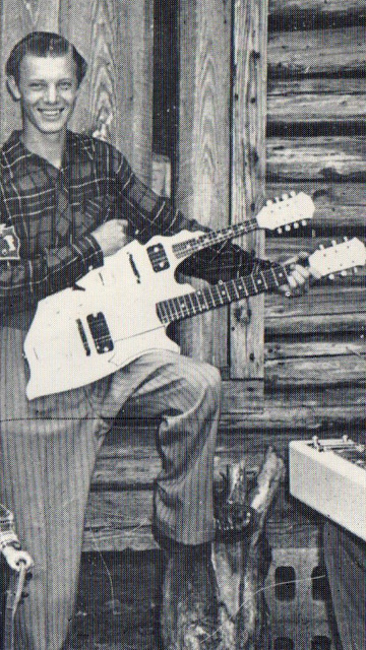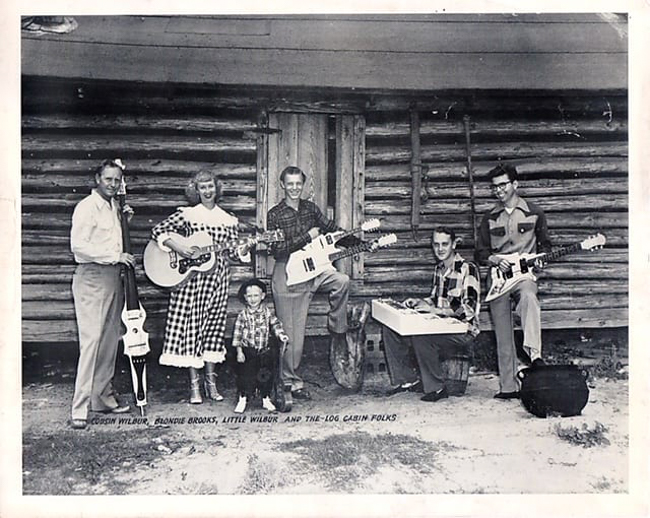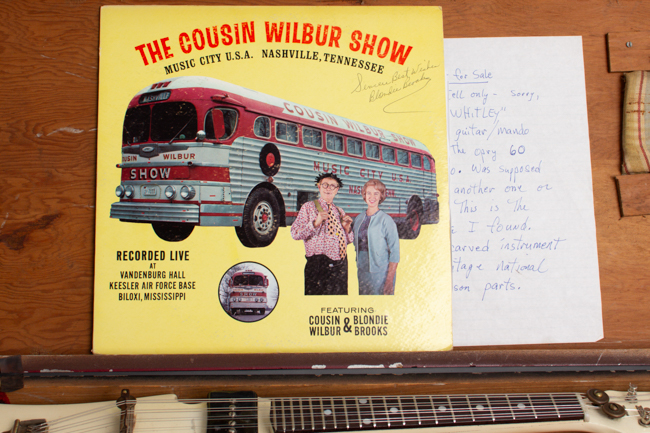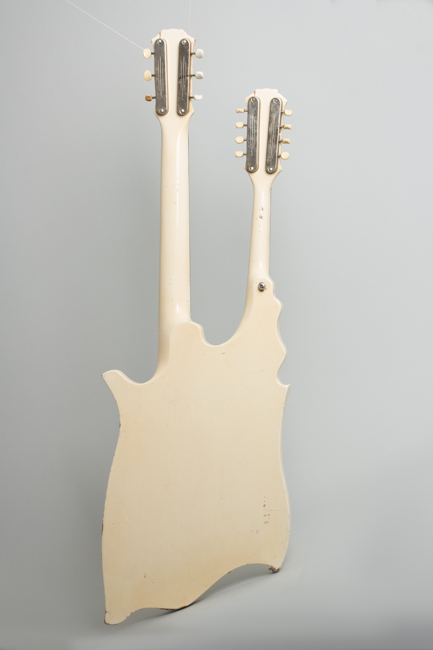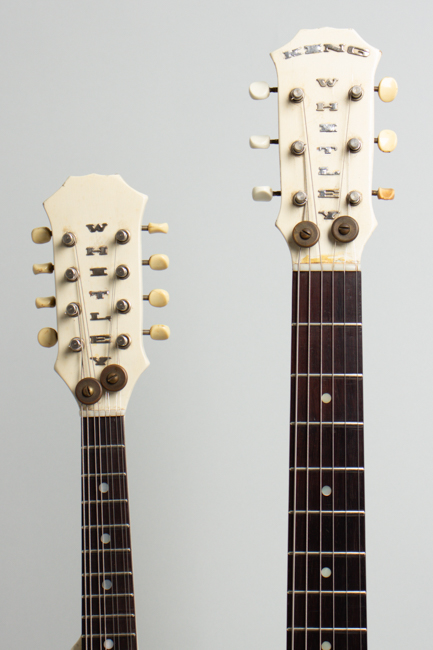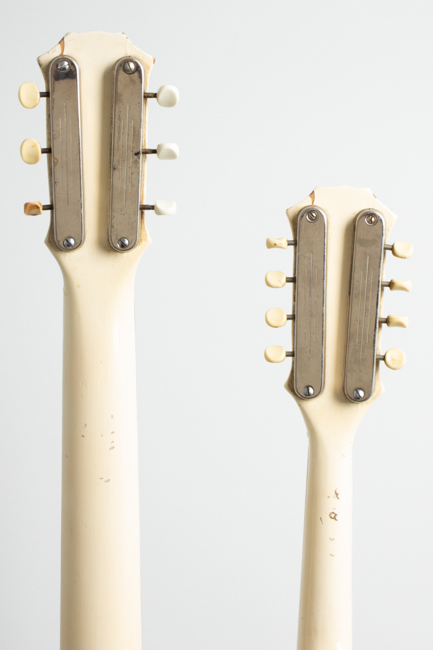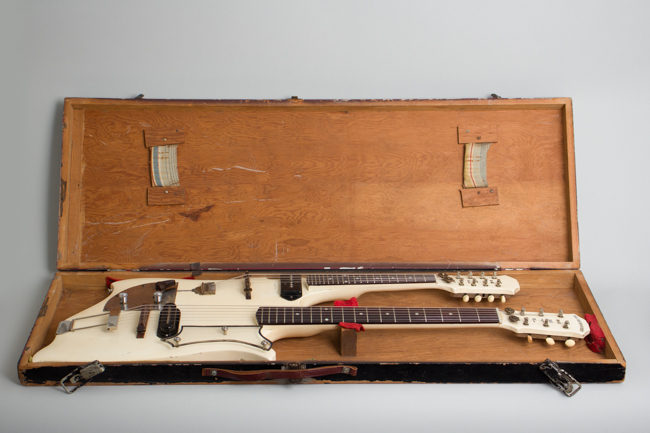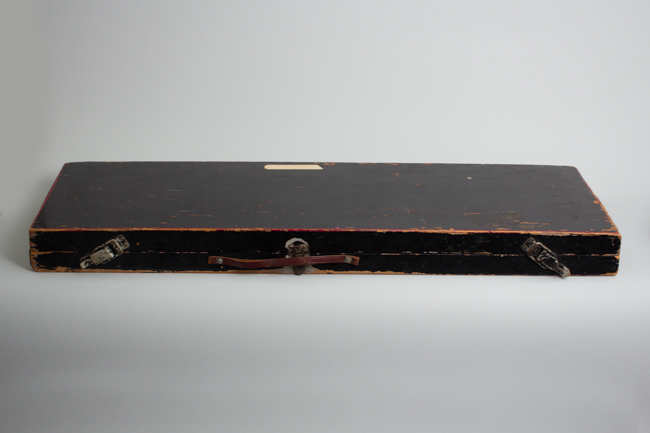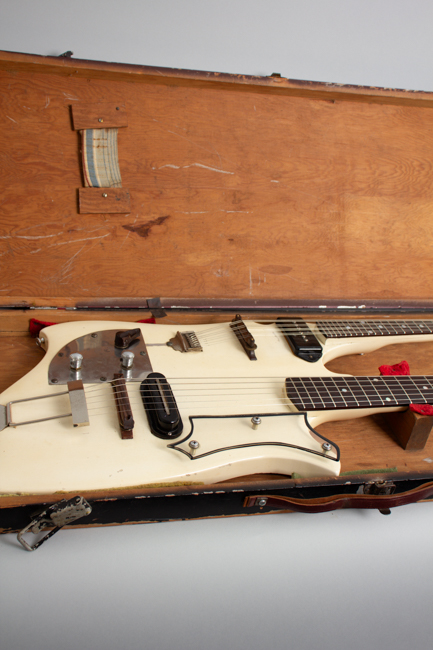Handmade Doubleneck Mandolin Solid Body Electric Guitar, labeled King Whitley (1950s)
This item has been sold.
Item # 11883
Prices subject to change without notice.
Handmade Doubleneck Mandolin Model Solid Body Electric Guitar, labeled King Whitley (1950s), origin unknown, white lacquer finish, hardwood body and necks, rosewood fingerboards, handmade black hard shell case.
Ladies and gentlemen, may we present the fabulous "King Whitley". We can't tell you who made this fantastic doubleneck mandolin/guitar piece of playable Hillbilly art, but we can tell you it has some history along the highways and backroads of Country Music history. It is a fully playable instrument, eccentric looking for sure but a good sounding one made with love and care.
Multi-neck instruments like this were a "thing" among ambitions country players in the 1950s, and as few were commercially available many folks either had one made to order or built one themselves. Paul Bigsby was the most celebrated custom guitar builder of the time, but many others both known (Semie Moseley, Doc Kauffman) and unknown produced such instruments on an individual basis. This one combines an 8-string mandolin upper deck with a lower 6-string guitar in a fairly compact abstract solidbody package, flashy for sure but quite functional as well.
While the builder is unknown, this is a professionally made instrument with an artfully carved liquid sculpture body that is clearly the product of an experienced woodworker. The body is slightly arched with sculpted edges and the white lacquer finish is very well done. The pickup and control cavity routs are somewhat cruder, but on a par with many '50s makers including Rickenbacker. The necks are nicely carved if a bit chunky (on the guitar side) while the fingerboard and fret work are pro quality. "KING WHITLEY" in mailbox letters in the headstocks could designate the maker of (more likely) a player.
The hardware was sourced from different places; the covered strip tuners were used by National in the '40s and early '50s. The tailpieces and wooden adjustable bridges are commercially available parts, although adapting the tailpiece to mount the jack was a neat customization. The pickups are hand wound using an original 1930's Epiphone blade unit and '50s Gibson P-90 as the source material. The electronics were scrounged from (probably) an old radio and are fairly crude (and rusty!). The 3-way switch allows for either neck to be on, but not both. The elevated clear pickguard and metal control plate are handmade, while the enormous string retaining discs on the headstock were probably an afterthought found in the toolbox!
While we can't tell you who made the instrument, we can shed SOME light on where it has been. This guitar is clearly pictured alongside at least two (!) other instruments by the same maker in a 1950s photo of Cousin Wilbur, Blondie Brooks and the Log Cabin Folks. Cousin Wilbur had a long career a singer, bass player and comedian from Tennessee. After performing with Eddy Arnold and fiddler Speedy McNatt, in 1940 he joined Bill Monroe's band on bass. He married Blondie Leatherman in 1947 and they performed as Cousin Wilbur and Blondie Brooks, with this instrument played alongside them. In the photo Wilbur holds a custom electric upright bass, while this guitar and a similar 6-string are brandished by two young (presumably hotshot!) guitarists. All appear to be from the same builder.
A nearly identical doubleneck appears in photographs with multi-generational country legends the Stonemans in the hands of Scotty Stoneman, a champion fiddle player fluent on many different instruments. Scotty played with his siblings in The Bluegrass Champs and the Stonemans and also The Kentucky Colonels with a young Clarence White. Whoever this maker was, he put his instruments in the hands of some interesting folks in the 1950s. While crude in some aspects, this doubleneck is surprisingly sophisticated in others. The single-pickup guitar has a bright Telecaster-like twang while the mandolin has quite a rich sound for an 8-string electric. And boy, does it ever catch the eye!
Overall length is 38 5/8 in. (98.1 cm.), 12 3/8 in. (31.4 cm.) wide at lower bout, and 1 1/8 in. (2.9 cm.) in depth, measured at side of rim. Scale length is 24 3/4 in. (629 mm.). Width of nut is 1 3/4 in. (44 mm.).
This guitar shows signs of use and minor alteration along the way, but remains a functional and fully playable piece of history. The white lacquer finish has some light checking and small dings, scratches and chips overall but no really heavy wear. There are a couple of feelable dinks on the backs of the necks, more deeply to the mandolin side. Some of the mailbox letters on the headstocks are hand-made repros, which is only apparent on fairly close inspection.
The instrument appears to have remained as built except for the pickups and the volume pot; the early photo shows what appear to be different handmade pickup units. Currently the instrument carries a re-worked 1930s Epiphone blade pickup on the guitar side, and a customized 1950s 6-pole Gibson P-90 on the Mandolin. We might have gone with using the blade pickup for the mandolin and the 6-pole P-90 style for the guitar, but who are we to argue with the Kingmaker? The electronic rig has a salvaged look about it; we did have to replace the very rusty volume pot with a later 250K pot for functionality but is retained in a baggie for history's sake.
The frets on both necks appear original (as far as it is possible to tell on a hand-made instrument) and show some minimal wear; the frets on the guitar side have been recrowned a bit. The necks are (perhaps surprisingly) actually nice and straight and within its eccentric limits this is a very playable instrument.
The pickups sound good have fairly low output but as they are not strictly "original" could easily be re-worked if desired. The guitar has a bright and clean tone, while the mandolin is somewhat sweeter sounding. The "Kong" resides in a hand-made rectangular case that is cruder than the instrument. We don't expect this will be anyone's gigging instrument again (although it could) but is an amazing piece of American guitar history and one of the coolest of these handmade "Hillbilly' instruments we have ever seen. Included is a rare period "Cousin Wilbur Show" LP which is pretty cool, but we can't tell you if this guitar is heard on it! Overall Excellent - Condition.
Ladies and gentlemen, may we present the fabulous "King Whitley". We can't tell you who made this fantastic doubleneck mandolin/guitar piece of playable Hillbilly art, but we can tell you it has some history along the highways and backroads of Country Music history. It is a fully playable instrument, eccentric looking for sure but a good sounding one made with love and care.
Multi-neck instruments like this were a "thing" among ambitions country players in the 1950s, and as few were commercially available many folks either had one made to order or built one themselves. Paul Bigsby was the most celebrated custom guitar builder of the time, but many others both known (Semie Moseley, Doc Kauffman) and unknown produced such instruments on an individual basis. This one combines an 8-string mandolin upper deck with a lower 6-string guitar in a fairly compact abstract solidbody package, flashy for sure but quite functional as well.
While the builder is unknown, this is a professionally made instrument with an artfully carved liquid sculpture body that is clearly the product of an experienced woodworker. The body is slightly arched with sculpted edges and the white lacquer finish is very well done. The pickup and control cavity routs are somewhat cruder, but on a par with many '50s makers including Rickenbacker. The necks are nicely carved if a bit chunky (on the guitar side) while the fingerboard and fret work are pro quality. "KING WHITLEY" in mailbox letters in the headstocks could designate the maker of (more likely) a player.
The hardware was sourced from different places; the covered strip tuners were used by National in the '40s and early '50s. The tailpieces and wooden adjustable bridges are commercially available parts, although adapting the tailpiece to mount the jack was a neat customization. The pickups are hand wound using an original 1930's Epiphone blade unit and '50s Gibson P-90 as the source material. The electronics were scrounged from (probably) an old radio and are fairly crude (and rusty!). The 3-way switch allows for either neck to be on, but not both. The elevated clear pickguard and metal control plate are handmade, while the enormous string retaining discs on the headstock were probably an afterthought found in the toolbox!
While we can't tell you who made the instrument, we can shed SOME light on where it has been. This guitar is clearly pictured alongside at least two (!) other instruments by the same maker in a 1950s photo of Cousin Wilbur, Blondie Brooks and the Log Cabin Folks. Cousin Wilbur had a long career a singer, bass player and comedian from Tennessee. After performing with Eddy Arnold and fiddler Speedy McNatt, in 1940 he joined Bill Monroe's band on bass. He married Blondie Leatherman in 1947 and they performed as Cousin Wilbur and Blondie Brooks, with this instrument played alongside them. In the photo Wilbur holds a custom electric upright bass, while this guitar and a similar 6-string are brandished by two young (presumably hotshot!) guitarists. All appear to be from the same builder.
A nearly identical doubleneck appears in photographs with multi-generational country legends the Stonemans in the hands of Scotty Stoneman, a champion fiddle player fluent on many different instruments. Scotty played with his siblings in The Bluegrass Champs and the Stonemans and also The Kentucky Colonels with a young Clarence White. Whoever this maker was, he put his instruments in the hands of some interesting folks in the 1950s. While crude in some aspects, this doubleneck is surprisingly sophisticated in others. The single-pickup guitar has a bright Telecaster-like twang while the mandolin has quite a rich sound for an 8-string electric. And boy, does it ever catch the eye!
Overall length is 38 5/8 in. (98.1 cm.), 12 3/8 in. (31.4 cm.) wide at lower bout, and 1 1/8 in. (2.9 cm.) in depth, measured at side of rim. Scale length is 24 3/4 in. (629 mm.). Width of nut is 1 3/4 in. (44 mm.).
This guitar shows signs of use and minor alteration along the way, but remains a functional and fully playable piece of history. The white lacquer finish has some light checking and small dings, scratches and chips overall but no really heavy wear. There are a couple of feelable dinks on the backs of the necks, more deeply to the mandolin side. Some of the mailbox letters on the headstocks are hand-made repros, which is only apparent on fairly close inspection.
The instrument appears to have remained as built except for the pickups and the volume pot; the early photo shows what appear to be different handmade pickup units. Currently the instrument carries a re-worked 1930s Epiphone blade pickup on the guitar side, and a customized 1950s 6-pole Gibson P-90 on the Mandolin. We might have gone with using the blade pickup for the mandolin and the 6-pole P-90 style for the guitar, but who are we to argue with the Kingmaker? The electronic rig has a salvaged look about it; we did have to replace the very rusty volume pot with a later 250K pot for functionality but is retained in a baggie for history's sake.
The frets on both necks appear original (as far as it is possible to tell on a hand-made instrument) and show some minimal wear; the frets on the guitar side have been recrowned a bit. The necks are (perhaps surprisingly) actually nice and straight and within its eccentric limits this is a very playable instrument.
The pickups sound good have fairly low output but as they are not strictly "original" could easily be re-worked if desired. The guitar has a bright and clean tone, while the mandolin is somewhat sweeter sounding. The "Kong" resides in a hand-made rectangular case that is cruder than the instrument. We don't expect this will be anyone's gigging instrument again (although it could) but is an amazing piece of American guitar history and one of the coolest of these handmade "Hillbilly' instruments we have ever seen. Included is a rare period "Cousin Wilbur Show" LP which is pretty cool, but we can't tell you if this guitar is heard on it! Overall Excellent - Condition.


